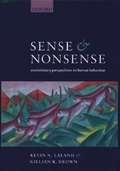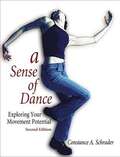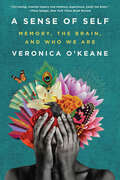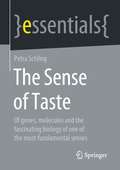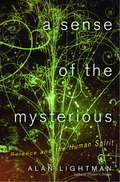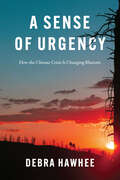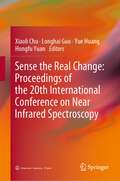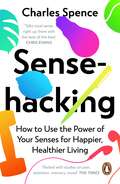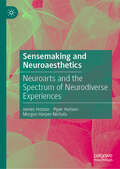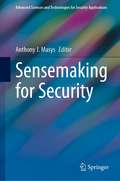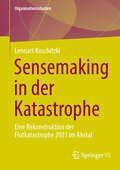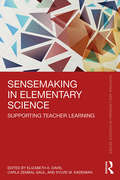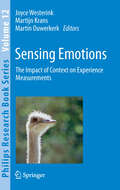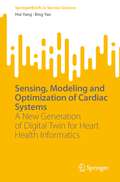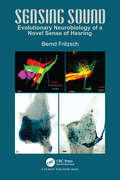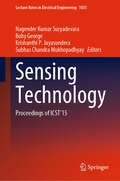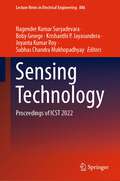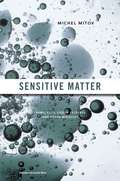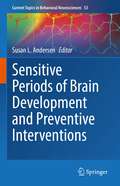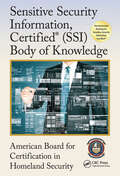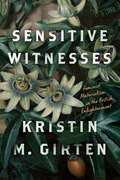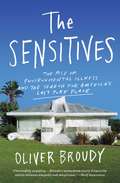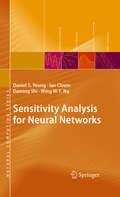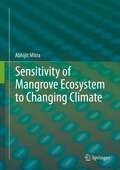- Table View
- List View
Sense and Nonsense: Evolutionary Perspectives on Human Behaviour
by Gillian Brown Kevin N. LalandReviewing a broad swath of the literature related to evolutionary treatments of the causes of human behavior, psychology, and culture, Laland and Brown (both researchers at the Department of Zoology, U. of Cambridge, UK) attempt to evaluate the relative worth of recent research and provide an account of where evolutionary theory holds some promise in explaining human behavior. Chapters individually examine sociobiology, behavioral ecology, evolutionary psychology, memetics, and gene-culture coevolution. A final chapter reflects on the possibilities of integrating the various approaches.
A Sense of Self: Memory, The Brain, And Who We Are
by Veronica O'KeaneHow do our brains store—and then conjure up—past experiences to make us who we are? A twinge of sadness, a rush of love, a knot of loss, a whiff of regret. Memories have the power to move us, often when we least expect it, a sign of the complex neural process that continues in the background of our everyday lives. This process shapes us: filtering the world around us, informing our behavior and feeding our imagination. Psychiatrist Veronica O’Keane has spent many years observing how memory and experience are interwoven. In this rich, fascinating exploration, she asks, among other things: Why can memories feel so real? How are our sensations and perceptions connected with them? Why is place so important in memory? Are there such things as “true” and “false” memories? And, above all, what happens when the process of memory is disrupted by mental illness? O’Keane uses the broken memories of psychosis to illuminate the integrated human brain, offering a new way of thinking about our own personal experiences. Drawing on poignant accounts that include her own experiences, as well as what we can learn from insights in literature and fairytales and the latest neuroscientific research, O’Keane reframes our understanding of the extraordinary puzzle that is the human brain and how it changes during its growth from birth to adolescence and old age. By elucidating this process, she exposes the way that the formation of memory in the brain is vital to the creation of our sense of self.
The Sense of Taste: Of genes, molecules and the fascinating biology of one of the most fundamental senses (essentials)
by Petra SchlingIn this essential, Petra Schling gives an overview of the current state of research on the topic of taste. She regards taste as a sensory perception that allows us to distinguish essential food components from toxins. What we eat depends not insignificantly on how we like it. But how do we actually taste - and what do we taste? As omnivores, we humans have a relatively wide range of taste receptors, not only in our mouths, which provide us with important information about our food. Outside the mouth, taste receptors serve our innate immune system to "taste" bacteria, worms and other intruders. We can and should rely on this. Our sense of taste warns us of toxins and unwanted co-inhabitants and can only be deceived to a very limited extent by sweeteners, bitter blockers or similar tricks.This Springer essential is a translation of the original German 1st edition essentials,Der Geschmack by Petra Schling, published by Springer Fachmedien Wiesbaden GmbH, part of Springer Nature in 2021.The translation was done with the help of artificial intelligence (machine translation by the service DeepL.com). A subsequent human revision was done primarily in terms of content, so that the book will read stylistically differently from a conventional translation. Springer Nature works continuously to further the development of tools for the production of books and on the related technologies to support the authors.
A Sense of the Future: Essays in Natural Philosophy
by Jacob BronowskiScientist, humanist, optimist, the late Jacob Bronowski in these essays explores the singularity of humankind, the essence of science, and the idea of a life force antecedent to nature.
A Sense of the Mysterious
by Alan LightmanFrom the bestselling author of Einstein's Dreams comes this lyrical and insightful collection of science writing that delves into the mysteries of the scientific process and exposes its beauty and intrigue.In these brilliant essays, Lightman explores the emotional life of science, the power of imagination, the creative moment, and the alternate ways in which scientists and humanists think about the world. Along the way, he provides in-depth portraits of some of the great geniuses of our time, including Albert Einstein, Richard Feynman, Edward Teller, and astronomer Vera Rubin. Thoughtful, beautifully written, and wonderfully original, A Sense of the Mysterious confirms Alan Lightman's unique position at the crossroads of science and art.From the Trade Paperback edition.ly written, A Sense of the Mysterious confirms Alan Lightman's unique position at the crossroads of science and art.From the Hardcover edition.
A Sense of Urgency: How the Climate Crisis Is Changing Rhetoric
by Debra HawheeA study of how the climate crisis is changing human communication from a celebrated rhetorician. Why is it difficult to talk about climate change? Debra Hawhee argues that contemporary rhetoric relies on classical assumptions about humanity and history that cannot conceive of the present crisis. How do we talk about an unprecedented future or represent planetary interests without privileging our own species? A Sense of Urgency explores four emerging answers, their sheer novelty a record of both the devastation and possible futures of climate change. In developing the arts of magnitude, presence, witness, and feeling, A Sense of Urgency invites us to imagine new ways of thinking with our imperiled planet.
Sense the Real Change: Proceedings of the 20th International Conference on Near Infrared Spectroscopy
by Xiaoli Chu Longhai Guo Yue Huang Hongfu YuanThis book features selected papers presented at the 20th International Conference on Near Infrared Spectroscopy. It discusses the latest progress in the field of near infrared spectroscopy from around the globe, including the advances in instrumentation, spectral interpretation and Chemometrics. In addition, it presents potential trends for near infrared spectroscopy in the next decade and highlights developments in process analytical technology, chemical imaging and deep learning. It can be used as a reference book for researchers and application personnel engaged in spectroscopy technology, Chemometrics, analytical instruments, on-site rapid or on-line analysis, process control and other fields. It will also be useful for undergraduates and postgraduates studying these topics.
Sensehacking: How to Use the Power of Your Senses for Happier, Healthier Living
by Charles SpenceThe world expert in multisensory perception on the remarkable ways we can use our senses to lead richer lives 'Talks total sense, lots of fun facts, right up there with the best of the best' Chris Evans'Packed with studies on pain, attention, memory, mood' The Times How can the furniture in your home affect your wellbeing? What colour clothing will help you play sport better? And what simple trick will calm you after a tense day at work? In this revelatory book, pioneering and entertaining Oxford professor Charles Spence shows how our senses change how we think and feel, and how by 'hacking' them we can reduce stress, become more productive and be happier.We like to think of ourselves as rational beings, and yet it's the scent of expensive face cream that removes wrinkles (temporarily), a room actually feels warmer if you use a warmer paint colour, and the noise of the crowd really does affect the referee's decision. Understanding how our senses interact can produce incredible results. This is popular science at its unbelievable best. 'Spence does for the senses what Marie Kondo does for homes' Avery Gilbert, author of What the Nose Knows 'Everything you need to know about how to cope with the hidden sensory overload of modern life, engagingly told' Robin Dunbar, author of How Many Friends Does One Person Need?
Sensemaking and Neuroaesthetics: Neuroarts and the Spectrum of Neurodiverse Experiences
by James Hutson Piper Hutson Morgan Harper-NicholsThis book investigates the complex interrelationships between neuroscience, arts, technical design, and the spectrum of neurodivergent conditions, introducing the emerging topic of neuroarts. It emphasizes the power of art and technologies as a multisensory tool for helping neurodivergent individuals discover their sensory preferences, and for neurotypical individuals to broaden their understanding of the world by simulating different sensory experiences. Drawing on the enactivism theory, which posits that cognitive processes are inherently shaped through the dynamic interplay between an organism and its environmental context, the authors discuss the applications of emerging technologies and propose a new theory to discuss and identify ‘neurotribes’ based on their relation to sense making or the body.A timely and well-needed resource for scholars in the fields of neuroaesthetics and neurodiversity, as well as art therapists, clinical psychologists, and medical practitioners specializing in neurodiversity and sensory perception disorders, this book can also serve cultural institutions developing inclusive experiences for a neurodiverse public, and professionals in the tech industry focusing on AI, augmented reality, and sensory technology.
Sensemaking for Security (Advanced Sciences and Technologies for Security Applications)
by Anthony J. MasysThis book presents sensemaking strategies to support security planning and design. Threats to security are becoming complex and multifaceted and increasingly challenging traditional notions of security. The security landscape is characterized as ‘messes’ and ‘wicked problems’ that proliferate in this age of complexity. Designing security solutions in the face of interconnectedness, volatility and uncertainty, we run the risk of providing the right answer to the wrong problem thereby resulting in unintended consequences. Sensemaking is the activity that enables us to turn the ongoing complexity of the world into a “situation that is comprehended explicitly in words and that serves as a springboard into action” (Weick, Sutcliffe, Obstfeld, 2005). It is about creating an emerging picture of our world through data collection, analysis, action, and reflection. The importance of sensemaking to security is that it enables us to plan, design and act when the world as we knew it seems to have shifted. Leveraging the relevant theoretical grounding and thought leadership in sensemaking, key examples are provided, thereby illustrating how sensemaking strategies can support security planning and design. This is a critical analytical and leadership requirement in this age of volatility, uncertainty, complexity and ambiguity that characterizes the security landscape. This book is useful for academics, graduate students in global security, and government and security planning practitioners.
Sensemaking in der Katastrophe: Eine Rekonstruktion der Flutkatastrophe 2021 im Ahrtal (Organisationsstudien)
by Lennart KoschitzkiDieses Buch bietet eine soziologische Perspektive auf die Flutkatastrophe 2021 im Ahrtal – und zeigt damit Strukturen und Bedingungen auf, welche im Hintergrund der Flutnacht zu ihren tragischen Ausmaßen führten. Nach Desastern steht oft die Frage im Raum, wie es trotz nachweislich vorliegender Warnsignale zu einer derartigen Eskalation kommen konnte. Auch nach der Flut im Kreis Ahrweiler erscheinen die Fehlentscheidungen bei den Verantwortlichen nicht nachvollziehbar. In diesem Buch wird zur Beleuchtung dieser Rätsel ein anderer Blickwinkel vorgeschlagen: Das kritischste Element der Flutkatastrophe und deren missglückter Bewältigung lag nicht in Fehlentscheidungen, sondern in den zugrundeliegenden Fehleinschätzungen. Unter Zuhilfenahme von „Sensemaking“ nach Karl E. Weick werden diese Fehleinschätzungen vom 14. und 15. Juli 2021 in ihren Kontexten sicht- und greifbar gemacht. Neben dem fokussierten Krisenstab in Bad Neuenahr-Ahrweiler werden auch weitere zentrale Akteure und widrige Gegebenheiten dieses Zusammenhangs untersucht. Darüber hinaus werden organisationale Einflussfaktoren der Flutkatastrophe herausgestellt; denn wie bei allen Katastrophen bildete sie sich aus dem Zusammenspiel mehrerer, teils völlig voneinander unabhängiger Aspekte. Für das ergänzende Verständnis wird neben einer einführenden Rekonstruktion des Katastrophenhergangs auch eine Einordnung von Krisenstäben als organisationaler Sonderform im hier betrachteten Sinne geboten. Daraus ergibt sich die Gelegenheit, aus den Geschehnissen im Kreis Ahrweiler zu lernen. Damit bietet dieses Buch insbesondere für Katastrophenforscher und Katastrophenschützer Impulse und Lektionen.
Sensemaking in Elementary Science: Supporting Teacher Learning (Teaching and Learning in Science Series)
by Elizabeth A. Davis Carla Zembal-Saul Sylvie M. KademianGrounded in empirical research, this book offers concrete pathways to direct attention towards elementary science teaching that privileges sensemaking, rather than isolated activities and vocabulary. Outlining a clear vision for this shift using research-backed tools, pedagogies, and practices to support teacher learning and development, this edited volume reveals how teachers can best engage in teaching that supports meaningful learning and understanding in elementary science classrooms. Divided into three sections, this book demonstrates the skills, knowledge bases, and research-driven practices necessary to make a fundamental shift towards a focus on students’ ideas and reasoning, and covers topics such as: An introduction to sensemaking in elementary science; Positioning students at the center of sensemaking; Planning and enacting investigation-based science discussions; Designing a practice-based elementary teacher education program; Reflections on science teacher education and professional development for reform-based elementary science. In line with current reform efforts, including the Next Generation Science Standards (NGSS), Sensemaking in Elementary Science is the perfect resource for graduate students and researchers in science education, elementary education, teacher education, and STEM education looking to explore effective practice, approaches, and development within the elementary science classroom.
Sensing Emotions
by Martijn Krans Martin Ouwerkerk Joyce WesterinkIn the future, products and machines will know how we feel and how to adapt to those feelings. This book analyzes the influence of specific everyday situations and contexts on the emotional state of people and ways this will impact future user experience.
Sensing, Modeling and Optimization of Cardiac Systems: A New Generation of Digital Twin for Heart Health Informatics (SpringerBriefs in Service Science)
by Hui Yang Bing YaoThis book reviews the development of physics-based modeling and sensor-based data fusion for optimizing medical decision making in connection with spatiotemporal cardiovascular disease processes. To improve cardiac care services and patients’ quality of life, it is very important to detect heart diseases early and optimize medical decision making. This book introduces recent research advances in machine learning, physics-based modeling, and simulation optimization to fully exploit medical data and promote the data-driven and simulation-guided diagnosis and treatment of heart disease. Specifically, it focuses on three major topics: computer modeling of cardiovascular systems, physiological signal processing for disease diagnostics and prognostics, and simulation optimization in medical decision making. It provides a comprehensive overview of recent advances in personalized cardiac modeling by integrating physics-based knowledge of the cardiovascular system with machine learning and multi-source medical data. It also discusses the state-of-the-art in electrocardiogram (ECG) signal processing for the identification of disease-altered cardiac dynamics. Lastly, it introduces readers to the early steps of optimal decision making based on the integration of sensor-based learning and simulation optimization in the context of cardiac surgeries. This book will be of interest to researchers and scholars in the fields of biomedical engineering, systems engineering and operations research, as well as professionals working in the medical sciences.
Sensing Sound: Evolutionary Neurobiology of a Novel Sense of Hearing
by Bernd FritzschHearing is a prerequisite for the evolution of language and thus the development of human societies. It is the only major sense whose evolution can be traced back to vertebrates, starting with sarcopterygians. The book explores the evolution of auditory development that has remained largely unexplored in contemporary theories of neurosensory brain evolution, including the telencephalon. It describes how sensory epithelia from the basilar papilla evolved in the ear and connected dedicated cochlear neurons to neuronal centers in the brain, and deals with how sound is converted through sound modulations into reliably decoded messages. The loss of hearing with age is expected to reach 2.6 billion people by 2050. As such, the book explains and reviews hearing loss at the molecular level to the behavioral level, and provides suggestions to manage the loss.
Sensing Technology: Proceedings of ICST'15 (Lecture Notes in Electrical Engineering #1035)
by Nagender Kumar Suryadevara Boby George Krishanthi P. Jayasundera Subhas Chandra MukhopadhyayThis book gathers the latest advances, innovations, and applications in the field of sensing technology, as presented by international researchers and engineers at the 15th International Conference on Sensing Technology (ICST), held in Sydney, Australia on December 5–7, 2022. Contributions include a wide range of topics such as: vision sensing, sensor signal processing, sensors phenomena and modelling, sensor characterization, smart sensors and sensor fusion, electromagnetic, chemical and physical sensors, electronic nose technology, biosensors, nano sensors, wireless sensors and WSN, Internet of Things, optical sensors, sensor arrays, intelligent sensing, Internet-based and remote data acquisition. The contributions, which were selected by means of a rigorous international peer-review process, present a wealth of exciting ideas that will open novel research directions and foster multidisciplinary collaboration among different specialists.
Sensing Technology: Proceedings of ICST 2022 (Lecture Notes in Electrical Engineering #886)
by Nagender Kumar Suryadevara Boby George Krishanthi P. Jayasundera Joyanta Kumar Roy Subhas Chandra MukhopadhyayThis book gathers the latest advances, innovations, and applications in the field of sensing technology, as presented by international researchers and engineers at the 14th International Conference on Sensing Technology (ICST), held in Chennai, India on January 17-19, 2022. Contributions include a wide range of topics such as: vision sensing, sensor signal processing, sensors phenomena and modelling, sensor characterization, smart sensors and sensor fusion, electromagnetic, chemical and physical sensors, electronic nose technology, biosensors, nano sensors, wireless sensors and WSN, Internet of Things, optical sensors, sensor arrays, intelligent sensing, Internet-based and remote data acquisition. The contributions, which were selected by means of a rigorous international peer-review process, present a wealth of exciting ideas that will open novel research directions and foster multidisciplinary collaboration among different specialists.
Sensitive Matter
by Michel MitovLife would not exist without sensitive, or soft, matter. All biological structures depend on it, including red blood globules, lung fluid, and membranes. So do industrial emulsions, gels, plastics, liquid crystals, and granular materials. What makes sensitive matter so fascinating is its inherent versatility. Shape-shifting at the slightest provocation, whether a change in composition or environment, it leads a fugitive existence. Physicist Michel Mitov brings drama to molecular gastronomy (as when two irreconcilable materials are mixed to achieve the miracle of mayonnaise) and offers answers to everyday questions, such as how does paint dry on canvas, why does shampoo foam better when you âeoerepeat,âe#157; and what allows for the controlled release of drugs? Along the way we meet a futurist cook, a scientist with a runaway imagination, and a penniless inventor named Goodyear who added sulfur to latex, quite possibly by accident, and created durable rubber. As Mitov demonstrates, even religious ritual is a lesson in the surprising science of sensitive matter. Thrice yearly, the reliquary of St. Januarius is carried down cobblestone streets from the Cathedral to the Church of St. Clare in Naples. If all goes as hopedâe"and since 1389 it often hasâe"the dried blood contained in the reliquaryâe(tm)s largest vial liquefies on reaching its destination, and Neapolitans are given a reaffirming symbol of renewal.
Sensitive Periods of Brain Development and Preventive Interventions (Current Topics in Behavioral Neurosciences #53)
by Susan L. AndersenSensitive periods occur when unique experiences permanently influence brain development either by their presence or absence. This volume covers underlying brain systems and behaviors that are sculpted by the environment in humans and animals in a search for commonalities. The mechanisms involved, the importance of timing in the process, and factors that can change the brain are discussed in this exciting book. Different chapters examine how experience guides the development of cells, circuits, and function using vision, cortical circuits, and cognition as frameworks. Scientific evidence for effective preventative intervention approaches, including diet, exercise, and music, are included to find ways to maximize child and adolescent development. The adverse effects of early brain injury are also included. As sensitive periods are gaining importance in their application in the real-world, novel statistical approaches for human studies are presented and the importance of sensitive periods are covered by examining the juvenile justice system. The book has interdisciplinary appeal and scholars with an interest in brain resiliency or vulnerability will find it of particular interest.
Sensitive Security Information, Certified® (SSI) Body of Knowledge
by 0 American Board for Certification in Homeland Security"Sensitive security information (SSI) is a category of sensitive but unclassified information under the United States government's information sharing and control rules. SSI plays a crucial role in all types of security. It is information obtained in the conduct of security activities which, if publicly disclosed, would constitute an unwarranted in
Sensitive Witnesses: Feminist Materialism in the British Enlightenment
by Kristin M. GirtenKristin M. Girten tells a new story of feminist knowledge-making in the Enlightenment era by exploring the British female philosophers who asserted their authority through the celebration of profoundly embodied observations, experiences, and experiments. This book explores the feminist materialist practice of sensitive witnessing, establishing an alternate history of the emergence of the scientific method in the eighteenth century. Francis Bacon and other male natural philosophers regularly downplayed the embodied nature of their observations. They presented themselves as modest witnesses, detached from their environment and entitled to the domination and exploitation of it. In contrast, the author-philosophers that Girten takes up asserted themselves as intimately entangled with matter—boldly embracing their perceived close association with the material world as women. Girten shows how Lucy Hutchinson, Margaret Cavendish, Aphra Behn, Eliza Haywood, and Charlotte Smith took inspiration from materialist principles to challenge widely accepted "modest" conventions for practicing and communicating philosophy. Forerunners of the feminist materialism of today, these thinkers recognized the kinship of human and nonhuman nature and suggested a more accessible, inclusive version of science. Girten persuasively argues that our understanding of Enlightenment thought must take into account these sensitive witnesses' visions of an alternative scientific method informed by profound closeness with the natural world.
The Sensitives: The Rise of Environmental Illness and the Search for America's Last Pure Place
by Oliver BroudyA compelling exploration of the mysteries of environmental toxicity and the community of &“sensitives&”—people with powerful, puzzling symptoms resulting from exposure to chemicals, fragrances, and cell phone signals, that have no effect on &“normals.&”They call themselves &“sensitives.&” Over fifty million Americans endure a mysterious environmental illness that renders them allergic to chemicals. Innocuous staples from deodorant to garbage bags wreak havoc on sensitives. For them, the enemy is modernity itself. No one is born with EI. It often starts with a single toxic exposure. Then the symptoms hit: extreme fatigue, brain fog, muscle aches, inability to tolerate certain foods. With over 85,000 chemicals in the environment, danger lurks around every corner. Largely ignored by the medical establishment and dismissed by family and friends, sensitives often resort to odd ersatz remedies, like lining their walls with aluminum foil or hanging mail on a clothesline for days so it can &“off-gas&” before they open it. Broudy encounters Brian Welsh, a prominent figure in the EI community, and quickly becomes fascinated by his plight. When Brian goes missing, Broudy travels with James, an eager, trusting sensitive to find Brian, investigate this disease, and delve into the intricate, ardent subculture that surrounds it. Their destination: Snowflake, the capital of the EI world. Located in eastern Arizona, it is a haven where sensitives can live openly without fear of toxins or the judgment of insensitive &“normals.&” While Broudy&’s book is wry, pacey, and down-to-earth, it also dives deeply into compelling corners of medical and American history. He finds telling parallels between sensitives and their cultural forebears, from the Puritans to those refugees and dreamers who settled the West. Ousted from mainstream society, these latter-day exiles nonetheless shed bright light on the anxious, noxious world we all inhabit now.
Sensitivity Analysis for Neural Networks
by Wing W. Ng Daming Shi Ian Cloete Daniel S. YeungArtificial neural networks are used to model systems that receive inputs and produce outputs. The relationships between the inputs and outputs and the representation parameters are critical issues in the design of related engineering systems, and sensitivity analysis concerns methods for analyzing these relationships. Perturbations of neural networks are caused by machine imprecision, and they can be simulated by embedding disturbances in the original inputs or connection weights, allowing us to study the characteristics of a function under small perturbations of its parameters. This is the first book to present a systematic description of sensitivity analysis methods for artificial neural networks. It covers sensitivity analysis of multilayer perceptron neural networks and radial basis function neural networks, two widely used models in the machine learning field. The authors examine the applications of such analysis in tasks such as feature selection, sample reduction, and network optimization. The book will be useful for engineers applying neural network sensitivity analysis to solve practical problems, and for researchers interested in foundational problems in neural networks.
Sensitivity of Mangrove Ecosystem to Changing Climate
by Abhijit MitraMangroves are basically salt tolerant forest ecosystems found mainly in tropical and sub-tropical inter-tidal regions. Till about 1960s, mangroves were largely viewed as "economically unproductive areas" and were therefore destroyed for reclaiming land for various economic and commercial activities. Gradually, with the passage of time, the economic and ecological benefits of mangroves have become visible and their importance is now well appreciated. Today, mangroves are observed in about 30 countries in tropical subtropical regions covering an area of about 99,300 Sq.Km. However, during the past 50 years, over 50% of the mangrove cover has been lost, mainly because of the increased pressure of human activities like shrimp farming and agriculture, forestry, salt extraction, urban development, tourist development and infrastructure. Also, dam on rivers, contamination of sea waters caused by heavy metals, oil spills, pesticides and other products etc. have been found to be responsible for the decline of mangroves. Although the temperature effect on growth and species diversity is not known, sea-level rise may pose a serious threat to these ecosystems The present book addresses all these important issues in separate chapters with some interesting case studies whose data may serve as pathfinder for future researches in the sphere of the influence of climate change on mangrove ecosystem. The role of mangroves in the sector of bioremediation is a unique feather in the crown of this coastal and brackishwater vegetation that may be taken up by the coastal industries in order to maintain the health of ambient environment. This book seeks to discover and to assess the vulnerability of climate change on mangrove flora and fauna, their role in carbon sequestration and some interesting case studies by some groups of dedicated researchers that may serve as the basis of future climate related policies.
